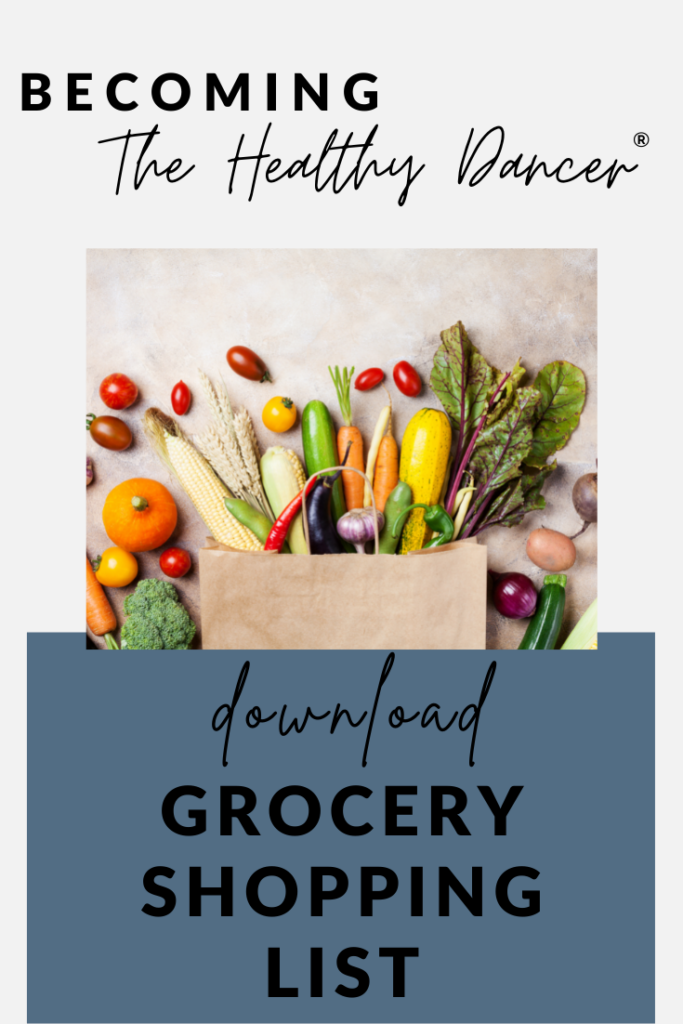For dancers, nutrition is critical for performance, endurance, and overall well-being. I’ve previously discussed shelf-stable pantry essentials for dancers. In this article, we’ll uncover a curated selection of grocery shopping tips tailored to meet the unique dietary needs of dancers. After you dive into my 3 key steps, don’t forget to grab your free grocery guide below!
#1: Plan ahead
Tackle your grocery trip with a well-planned list. First, check the foods you already have in your cabinets and fridge. Then build a list to fill the gaps. A checklist of supermarket staples makes this process easier (you can grab mine below!). This running list also helps to reduce food waste and save money— you’re less likely to purchase foods you already have or don’t necessarily need. Meal prep can make this step easier- here’s an article that walks you through it!
#2: Stroll the aisles
Now that you’ve compiled a list, let’s plan your trip. Most supermarkets are built around a similar concept: refrigerators and freezers line the perimeter. This is meant to keep fresh foods cold, and thus safe for consumption without the potential for bacterial contamination. These foods often include: produce, meat, seafood, dairy, sprouted bread, and the items filling freezer cases.
#3: Know your game plan
You’ve built a list and perfected your navigation at the store. But what will you choose to fill your cart? Here’s some help:
From the Produce Aisle: Fruits and vegetables are rich in vitamins, minerals, and antioxidants. Antioxidants help to rid the body of free radicals, which naturally form during strenuous exercise. Another bonus? Fruits and veggies are high in magnesium and phosphorus, supporting energy metabolism. Shop for a rainbow of colors. Look for a variety of these 5 subgroups: greens, reds/oranges, white (like cauliflower and potatoes), and blues/purples.
From The Meat/Seafood Counter: Animal-based protein contains all essential amino acids required for muscle building. Incorporating proteins will help you recover from the normal wear and tear of dancing. Try sources like poultry, meat, fish, and eggs. If you’re a vegan or vegetarian dancer, all essential amino acids can be obtained from your plant-based diet.
From The Dairy Case: Yogurt, kefir, cheese, and milk supply you with protein, calcium, phosphorus, and vitamin D. Each plays an essential role in building strong bones. Plant-based dancers need not worry as dairy alternatives like soy- and fortified nut-based options help to supply these essential nutrients.
From The Bread Case: Shopping for bread can be tricky. Try sprouted options found in the refrigerators or freezers. You can also try a freshly baked loaf from your supermarket’s bakery. When whole grains are listed as an ingredient, you’ll feel more energized from the fibrous grains and seeds.
From The Frozen Aisle: Stocking up on frozen produce is a budget-friendly way to get more plants on your plate. They’re also just as nutritious as fresh fruits and veggies and (my favorite) they don’t spoil quickly!
From The Snack Aisles: Legumes, oils, canned seafood (like tuna), grains, crackers, breakfast cereals, oatmeal, jars of nut butter, jams, nuts, seeds, and whole-grain crackers are all great options. Canned beans are a convenient, budget-friendly choice (rinse before use)! The nutrition facts label can help you decipher those nutrient-dense options, but you’ll first want to read this article to assess your use of those labels. When choosing a breakfast cereal, look for whole grains in the ingredient list. This will give you a boost in fiber, which keeps you feeling fuller throughout the morning. Last, a nut- and seed butter is another great pantry staple.



